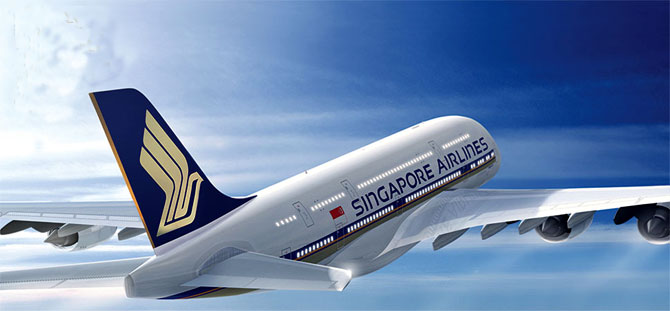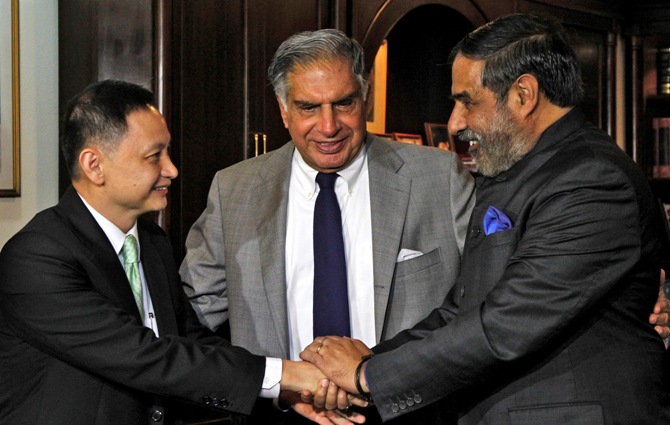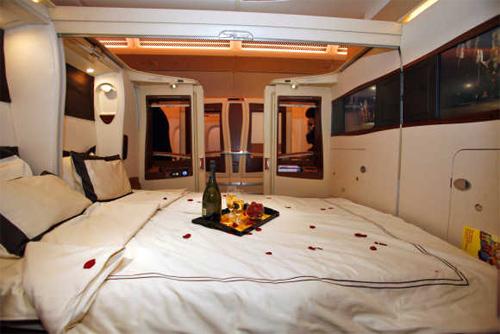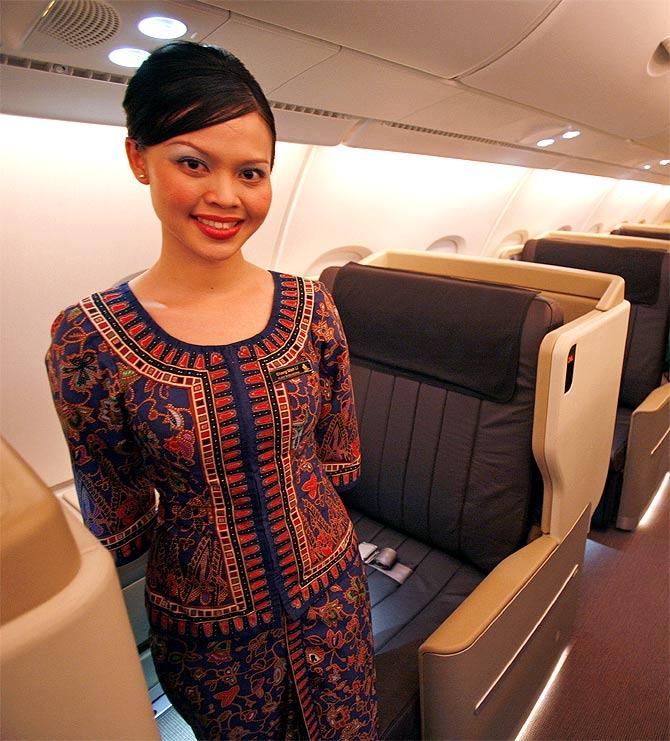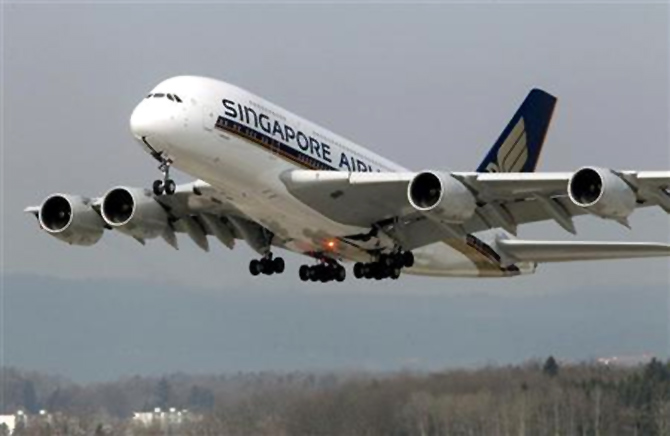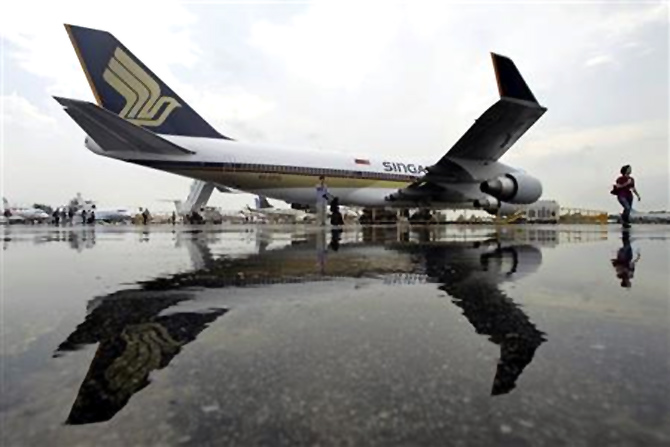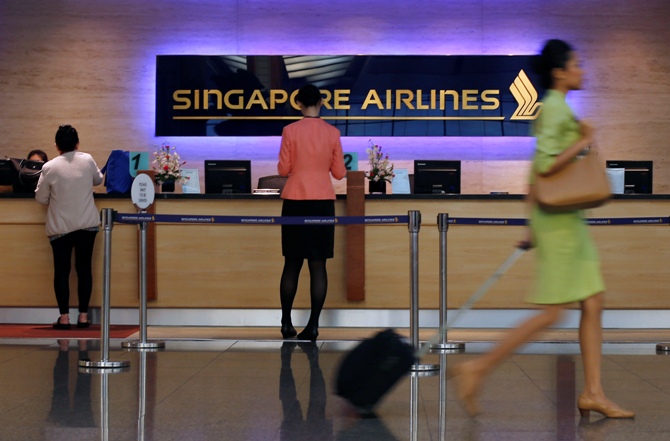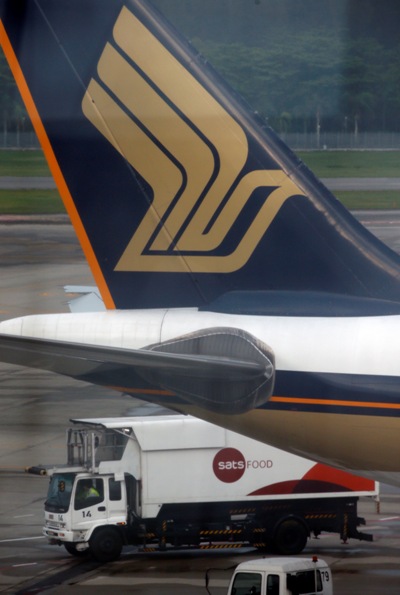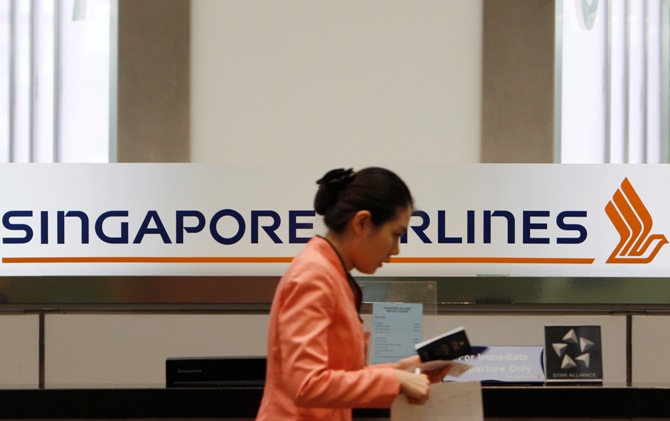 | « Back to article | Print this article |
Tata-SIA's plans for India go beyond fare
As a full-service carrier, Tata-Singapore International Airlines, or Tata-SIA, faces an unusual challenge.
Indian full-service carriers Jet Airways and Air India are mired in losses because they sell tickets at almost the same price as low-cost carriers like IndiGo and SpiceJet, though their costs are as much as 50 per cent higher.
Elsewhere in the world, there is a difference of at least 50 per cent between the two fares. If this is the established business model, is there any hope for the new airline?
Also, won’t its fares clash with Tata Sons’ low-cost carrier with AirAsia?
Tony Fernandes of AirAsia has acknowledged there could be some cannibalisation between Tata-SIA and AirAsia in India.
Click NEXT to read further. . .
Tata-SIA's plans for India go beyond fare
Tata-SIA can get higher yields than low-cost carriers because it will have business class seats which it can sell at a premium.
According to industry estimates, business class seats typically account for 8 to 10 per cent of the total domestic airline capacity but contribute 15 to 20 per cent of its revenue. The average business class fare is three to six times that of an economy seat.
In other words, it means 18 business class seats would give you the same revenue as at least 54 economy passengers.
That obviously increases the average yield per passenger.
This makes it a lucrative business proposition if leveraged effectively.
Click NEXT to read further. . .
Tata-SIA's plans for India go beyond fare
The winning formula
Full-service carriers have followed two strategies to address the market.
State-owned Air India, for instance, follows a hybrid model and has both all-economy flights as well as flights with business class seats.
Jet Airways, on the other hand, has business class in almost all its aircraft (except ATRs which it uses for short-haul flights); however, its size varies from just eight seats to as much as 28 seats.
Tata-SIA, at least for the first four years, say analysts, has decided to have 16 to 18 business class seats on all its flights.
Click NEXT to read further. . .
Tata-SIA's plans for India go beyond fare
Tata-SIA’s strategy is to segment the full-service market and only fly on sectors that support business class travel.
That is why it has decided to fly to just the key metros and big cities, rather than spread itself thin across too many cities.
Its carefully chosen strategy was revealed last week when Tata-SIA disclosed its four-year operational plan to the government in order to get its air operators permit.
In the first year of operations, it will mount 87 flights a week to 11 destinations.
It will gradually scale it up to 301 flights and 21 destinations in the fourth year of operations.
Of course, the business plan could alter if the government changes its policy and removes the clause which permits domestic airlines to fly abroad only after five years.
Click NEXT to read further. . .
Tata-SIA's plans for India go beyond fare
On the surface, based on the proposal submitted to the government, the number of flights that Tata-SIA plans to operate looks very small compared to the size of the Indian market.
For instance, all airlines -- full-service as well as low-cost -- fly over 11,934 domestic flights in a week.
What Tata-SIA plans to fly in the first year is less than 1 per cent of this capacity.
Full-service carriers fly over 4,246 flights a week. Tata-SIA’s capacity will be 2 per cent of this.
Also, assuming there is no expansion by the other full-service carriers, Tata–SIAs share will be just 7 per cent of in the fourth year.
Click NEXT to read further. . .
Tata-SIA's plans for India go beyond fare
But scratch the surface and you will find sound logic in the Tata-SIA route plan.
Full-service carriers control only 35 per cent of the domestic passenger traffic, but what is more important is that as much as 85 per cent of all business comes from only six metros.
And these metros constitute for the bulk of the business class traffic.
It is obviously this market that Tata-SIA is concentrating on.
It will focus on the four key metros: Delhi, Mumbai, Bengaluru and Hyderabad.
For instance, the Delhi-Mumbai sector, which is the nerve centre for corporate travel in the country, constitutes nearly a third of all the frequencies (directly or indirectly) in Tata-SIA’s plan for the fourth year of operations.
Click NEXT to read further. . .
Tata-SIA's plans for India go beyond fare
Apart from direct flight between the two cities, there will be flights via Ahmedabad and Jaipur.
And Goa flights will go after a stop in Mumbai.
Along with Delhi-Mumbai, its service from Delhi to Hyderabad and Bengaluru will constitute half of the total frequencies.
It wants to tap other lucrative business centres too like Ahmedabad, Chennai and Kolkata.
Filling the vacant space
Tata-SIA could also take advantage of the fact that Jet Airways and Air India are reducing their capacity in the domestic routes.
Thus, Jet Airways has reduced 384 flights a week, while Air India has cut 63 flights a week this summer.
Click NEXT to read further. . .
Tata-SIA's plans for India go beyond fare
Experts say Jet Airways is integrating its flight schedule with that of Etihad which has meant withdrawing flights from some cities like Kolkata. It is this share which Tata-SIA could grab.
That is one part of the game.
The other key aspect, of course, will be to pare costs.
To begin with, unlike its competitors which have night hubs in various parts of the country, Tata-SIA is the first domestic airline which will have only one hub: Delhi.
So all flights will depart and come back in the night to the capital city.
This, experts say, will help in reducing costs as the airline requires only one maintenance centre.
Click NEXT to read further. . .
Tata-SIA's plans for India go beyond fare
It will house inventory and the infrastructure needed for night halts at one place instead of managing multiple hubs which can increase costs.
Also, Tata-SIA is looking to outsource a substantial chunk of its ‘non-core’ business, even though it is still debating the difference between core and non-core businesses.
In addition, Tata-SIA is expected to fly its aircraft 12 to 13 hours a day, which is more than a full-service carrier like Air India (11 to 12 hours) and in line with low-cost carriers.
Analysts also say that it will have some leeway to charge a premium even on economy during peak seasons.
Click NEXT to read further. . .
Tata-SIA's plans for India go beyond fare
“While the economy fares of full-service carriers are the same as those of low-cost carriers during the lean season, there is a difference of 10 per cent to 20 per cent in the peak season.
“If you offer better service, you can always increase this premium” says an aviation executive.
Tata-SIA did not respond to a questionnaire sent to it.
If everything goes fine, Tata-SIA will be in air by September or October this year.
The question is whether it will be able to grow full-service segment which is increasingly being attacked by low-cost operators.
Click NEXT to read further. . .
Tata-SIA's plans for India go beyond fare
Tight ship
Tata-SIA is a new venture and does not carry legacy costs like Jet Airways and Air India.
As it starts from a clean slate, it can keep its costs on a tight leash and bring them closer to low-cost carriers.
Thus, unlike Air India which has an aircraft-employee ratio of 1: 232 (this includes the employees of its two subsidiaries for engineering services and ground handling) and Jet Airways which has a ratio of 1:138, experts say Tata-SIA is looking at a ratio of around 1:100.
